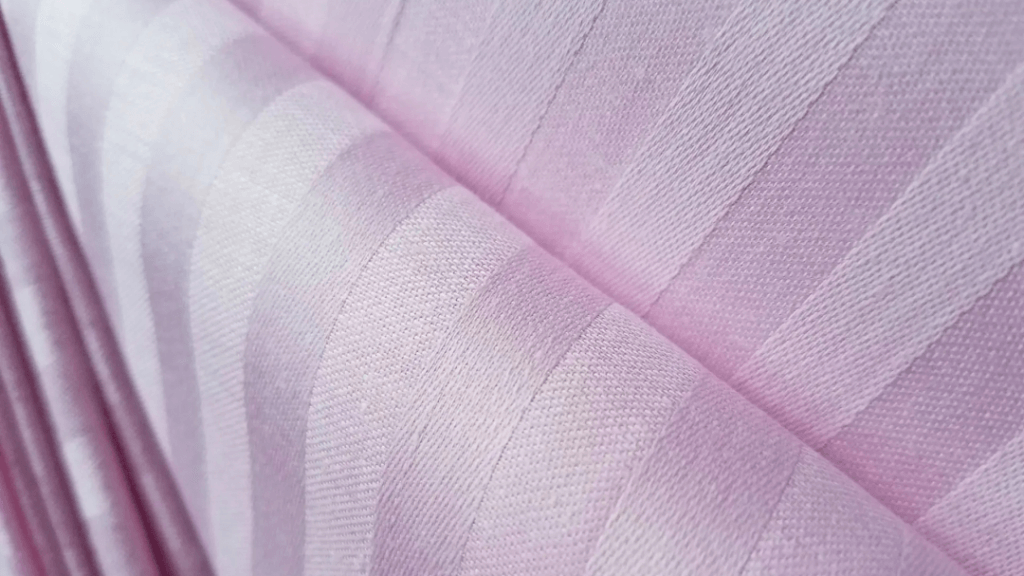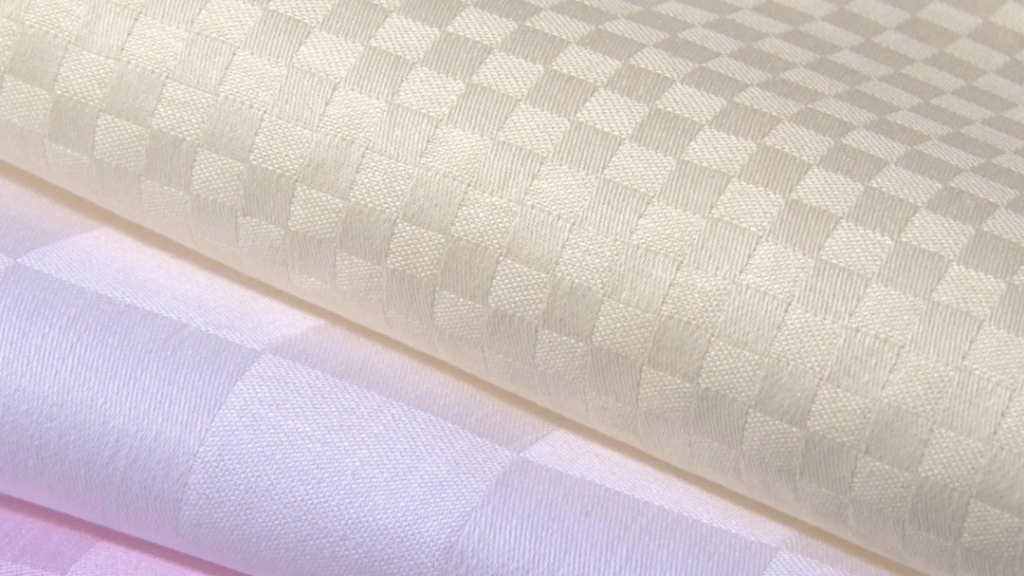Satin fabric

- Basic Concepts
Satin fabric, also known as satin fabric, is a kind of fabric with complicated weaving process. It is a combed fabric with a density of 173*124CM that is interwoven at least once every three yarns between warp and weft. It was named for its good quality characteristics as a “tribute” to the emperor. - Production process
(1) During the weaving process, the warp and weft yarns are interlaced at least once every three yarns, and the unique pattern is formed by the interlacing. There must be at least five warp/weft yarns in a complete weave;
(2) The number of interlacing of warp and weft is less than that of twill, independent and discontinuous with each other, and the intersection is basically invisible;
(3) There are longer warp/weft yarns covering the surface of the fabric;
(4) Generally, the number of yarns is 40 to 60;
(5) The combing density is 173*124CM;
(6) The fabric is mercerized during the printing and dyeing process, which increases the brightness and softness of the fabric;
(7) The fabric itself needs a high density, which is relatively expensive
- Fabric Features
The texture is soft, the surface is smooth, the elasticity is good, the air permeability is good, the fabric is relatively smooth and feels good, and the process is expensive.
Satin Jacquard Fabric

- Basic Concepts
The satin jacquard is directly woven into the fabric, which looks like a watermark with a concave and convex texture. It is based on the satin fabric and is woven with a small jacquard process.
- Production process
① The processing technology of satin jacquard should be woven first and then dyed;
② The satin jacquard uses two or more different weaves, or cooperates with yarns suitable for different raw materials, so that the surface pattern can be layered and the design effect can be achieved;
③ The warp and weft weave changes are used to form flower patterns during fabric weaving. The yarn count is fine, and the requirements for raw cotton are extremely high. And because the pattern needs to be woven directly into the cloth, the density of the cloth must reach a certain level in order to show the exquisite jacquard pattern. If the fabric of ordinary density is used, the pattern will be unclear.
- Fabric characteristics
① The biggest advantage of jacquard fabric is that the solid color is natural, simple and fashionable;
② The effect of satin jacquard is better than other materials, and the brightening effect on the bedroom is very obvious;
③ The product features retain the unique soft texture of the satin fabric, which is delicate and smooth, with better gloss and better hand feeling;
④ Good drape and air permeability, high color fastness (yarn dyeing);
⑤ The color and texture are more beautiful and pleasing to the eye than pure satin, showing more layers and changes;
⑥ The pattern cannot be washed off with water, no matter how many times it is washed, it can always be kept as new and will not turn white or gray;
⑦ Suitable for all kinds of furniture, and always makes people feel thick and warm.
- Washing instructions
(1) Use neutral detergent, do not use bleach. The stronger the stain removal ability, the stronger the chemical property, which will definitely aggravate the floating color phenomenon. It is recommended to use laundry detergent for cleaning.
(2) The washing water temperature should not exceed 35 ℃, do not soak, please adjust the washing machine program to the gentle setting.
(3) After washing, please drop it to dry, iron at medium temperature, and do not expose it to the sun.
(4) After drying, please fold it neatly and put it in the wardrobe, and at the same time put an appropriate amount of bagged camphor sheets.
(5) For those who love clean, if you need to clean it before using it, please wash it with cold water and some salt, but do not add washing powder, so that the pulp and printing and dyeing floating color on the surface of the cotton fabric can be washed off, and it will be more difficult to use when using Soft and also makes the color firm.
Classification of satin fabrics
01 Satin striped fabric (referred to as “satin stripe”
The lines are extended horizontally, and the process of weaving first and then dyeing is adopted, and the fabric is generally solid color. The pure cotton fabric has a slight shrinkage, no pilling, and is not easy to fade.

02 Satin plaid fabric (referred to as “satin” lattice)
The texture is a cross-extension of vertical and horizontal strips, which is a lattice-like pattern. Using the first weaving and then dyeing process, the fabric is generally solid color. The pure cotton fabric has a slight shrinkage, no pilling, and is not easy to fade.

03 Satin jacquard fabric (referred to as “small jacquard”)

The pattern on the Satin jacquard fabric is not ordinary printing or embroidery, but is woven with yarn. When the fabric is weaved, the warp and weft structure changes, and the warp and weft are intertwined to form different patterns, forming a pattern, fine yarn count, and high needle thread density. The fabric is generally very thin, not thick, and very soft and dense. It has high requirements on cotton and requires finer yarn counts, generally around 40s. In addition, the larger the count, the thinner the count, the smaller the count, the thicker the woven fabric, and the thickness depends on the count of your fabric. Generally, the count of sateen is about 40. The surface of the satin jacquard fabric with the process of first weaving and dyeing is uneven, and beautiful patterns such as flowers, birds, fish, insects, birds and beasts can be weaved by warp and weft threads. Soft, delicate and smooth unique texture, good gloss, good drape and breathability, high color fastness (yarn dyeing). The pattern of jacquard fabric is large and exquisite, and the color layer is distinct and three-dimensional. It is not deformed or faded when used, and it has a good comfort.
Exquisite jacquard fabrics

Exquisite jacquard fabrics are thick fabrics with double or multi-layer complex weave structure, named for their pattern characteristics and uses. Jacquard is different from dobby. The main difference between the two is the process. For consumers, the difference is that jacquard can weave a much richer pattern than small jacquard. The jacquard cloth feels plump, thick in texture, sturdy and wear-resistant, has good air permeability, and is comfortable to sit on without being stuffy or damp. The pattern has layers, and the concave and convex have a special sense. Therefore, compared with ordinary fabrics, jacquard fabrics are more comfortable, durable, and have beautiful patterns, and are more suitable for home use.
Related Article
What are flame-retardant fibers?
What are PET, PBT, and PTT fibers? Do you know the difference between them?
Read moreWhat are PET, PBT, and PTT fibers? Do you know the difference between them?
